31 Days, 31 Lists: 2022 Science and Nature Books for Kids

Merry . . . . uh . . . Science and Nature Books Day?
Okay, it’s a little random to have this particular list on this particular day, but what the heck! I love how much I’ve learned about both science and nature thanks in large part to the children’s books I’ve read. And while I have you here, I need to do some shameless plugging. You see, in my daylight hours I work at Evanston Public LIbrary in Evanston, Illinois. My fellow librarians are, in many ways, more talented than I. So much so that one of them by the name of Martha Meyer went so far as to create a children’s book award called the Blueberry (a play on the “Newbery”) that, “honors the best children’s books for 3 – 10 years olds published last year that inspire a love of nature and action for the planet.”
Because I have served on this award, I see books I might otherwise miss in a given year. Here then are some titles that are not only worthy of this list, they are “Blueberry-worthy” as well.
ADVERTISEMENT
ADVERTISEMENT
Interested in seeing other books for kids about science and nature? Then check out these previous lists:
2022 Science and Nature Books for Kids
Picture Books
Bei Bei Goes Home: A Panda Story by Cheryl Bardoe
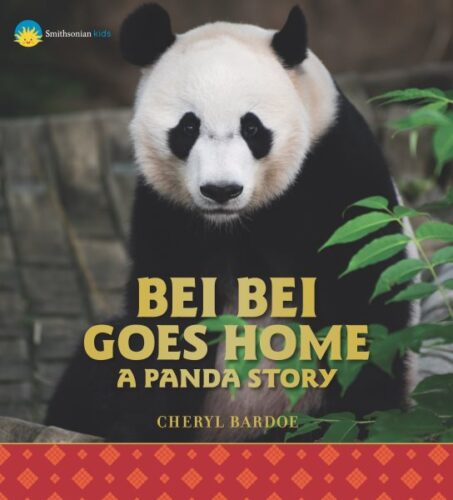
Born in America, Bei Bei the panda came into this world at the Smithsonian National Zoo in Washington D.C. The story of how he grew and made the trip to his final home in China is accompanied by magnificent photography and a plethora of fun “Panda Facts”. Cheryl Bardoe was the same author that brought us the truly fabulous Nothing Stopped Sophie a couple of years ago. And we’ve seen a number of nonfiction panda-related titles over the years but what makes this one stick out is not simply the US/China cultural exchange, but also the sheer number of photographs Bardoe managed to acquire along the way. This book goes beyond the simple “pandas are cute” idea and discusses a lot of aspects of their lives (like the fact that you never really know when one is going to give birth) in a very natural way.
Bioblitz! Counting Critters by Susan Edwards Richmond, ill. Stephanie Fizer Coleman
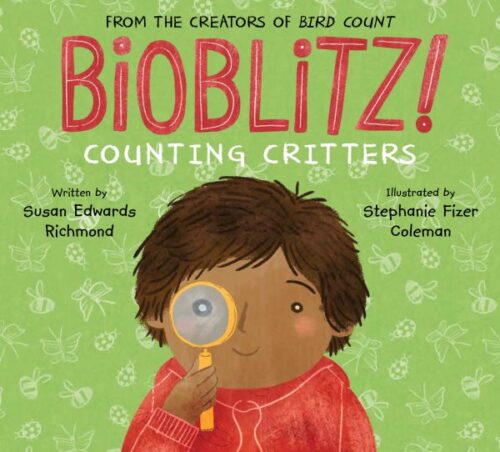
Gabriel is so excited. He and his cousin Ava get to participate in a Bioblitz biodiversity search at the park. How many critters can they count in one day and who will count the most? All right! A follow-up to that nice Bird Count picture book from a year or two ago! See, this is how you do a book about counting insects, birds, mammals, etc. as part of a “bioblitz”. Richmond and Fizer cleverly set the book up so that as the characters count different creatures, the reader can as well. It sort of becomes a low-key seek-and-find story, while at the same time making you excited to go out and join a bioblitz of your own. And even there, Richmond has your back with multiple resources at the end that indicate where to find one. This is citizen scientist writing at its very best. Great, good stuff.
Bobcat Prowling by Maria Gianferrari, ill. Bagram Ibatoulline

A yearling bobcat searching for a new place to live, in this gorgeously rendered fact-filled look at the life of these wild cats. While I freely acknowledge that were I to see a bobcat in my own backyard, I’d do a nice little freakout, but in this book I just find the whole notion cool. I was already a fan of this pair’s coyote and hawk books (Coyote Moon and Hawk Rising). A bobcat is just a natural next step. Giant kitties that could kill you!! Great backmatter and just great shots of a wild cat making its way across different landscapes. Well worth a couple reads
Dragon Bones: The Fantastic Fossil Discoveries of Mary Anning by Sarah Glenn Marsh, ill. Maris Wicks
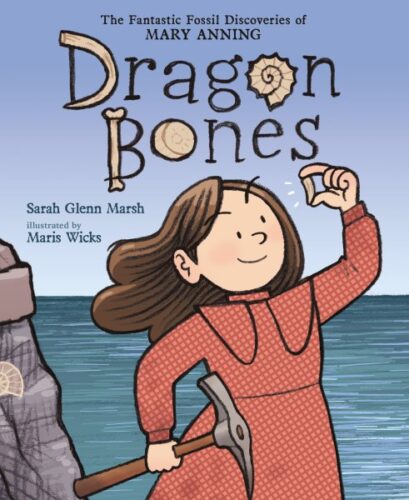
Since she was born in 1799, no one would have expected Mary Anning to be remembered as the mother of paleontology. But since she just keep digging up bigger, more impressive ancient sea creatures, what we know now would have been completely different without her. Oh, I LIKED this! Now admittedly this might partly be because I remember illustrator Maris Wicks from one of my favorite camping picture books Yes, Let’s. I love her style and how her seemingly simple art captures expressions and personalities so well. But let’s not give short shrift to Sarah Glenn Marsh! She does an excellent job of laying out not simply Mary’s life but also what the scientific community owes to her industrious nature. It’s a really neat story, not just about ancient fossils and paleontology, but also citizen science, the role of women, lack of attribution, and history itself. Extra points for the endpapers (where you can see the creatures as fossils at the front and as they would have looked at the end) and for the images of “Mary’s Dragons” particularly the Dimorphodon macronyx. It was so weird looking that I had to Google it, just to make sure Ms. Wicks wasn’t making up stuff (Google it yourself if you don’t believe me). Oh! And I LOVED LOVED LOVED the part that actually gives you practical information on how to become a paleontologist. Can we get that info in all our books about cool jobs, please?
Footprints by Jennifer Swanson

A photographic dive into footprints from all kinds of animals, as well as a consideration of the ways in which we humans leave our own marks on the land. I mean, it’s full of gorgeous stock photography, so what’s not to like? I also respect that Swanson decided to make the unconventional choice of starting the book with the rote here’s-what-different-animal-footprints-resemble motif, and then morphs it into a larger consideration of what we humans do with our own, more metaphysical, “footprints”. It’s a cool take on an old idea.
Good Eating: The Short Life of Krill by Matt Lilley, ill. Dan Tavis
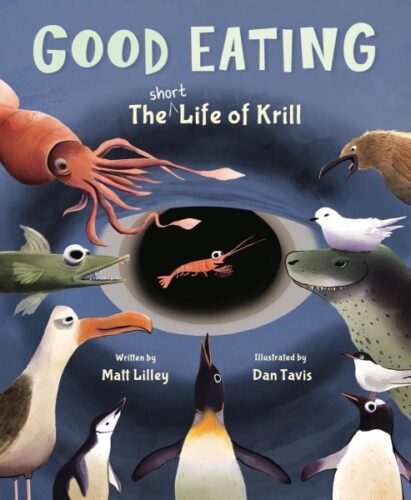
My true appreciation of a work of nonfiction for younger readers never burns brighter than when I am able to take a book, look it right in the eye, and say, “GAAAAHHH! NATURE IS SO WEIRD!!!” And friends, I am delighted to say that this little book by Lilley and Tavis, gave me that warm panicked feeling in my belly I always strive for. Yes, this is a book about krill. If you’re an adult like myself then you may know roundabout two facts about krill: 1. They are important to the oceans from an environmental standpoint and 2. Whales eat them by the truckload but they’re small. Therein begins and ends what I knew about the little buggers. That is also why I found GOOD EATING to be so delightful. Because Matt Lilley does not begin where you might expect him to. He starts with a shot of a single, solitary egg. “Hey, egg. What are you doing? Are you sinking?” Painted a luminous golden brown against a sea of black, the egg sinks down, more than a mile. Yet when it hatches, it’s still spherical. To my delight, your average krill is a far stranger story of metamorphosis than anything our butterflies can come up with. Constantly growing and shedding and growing and shedding (and not, for quite some time, eating) krill are shapeshifters. Even when they reach their final state, they’re still shedding armor. This deep dive into the microcosm of their lives is as elucidating as it is mesmerizing. You’ll never think about them the same way again.
Good Night to Your Fantastic Elastic Brain by JoAnn Deak, PhD and Terrence Deak, PhD, ill. Neely Daggett
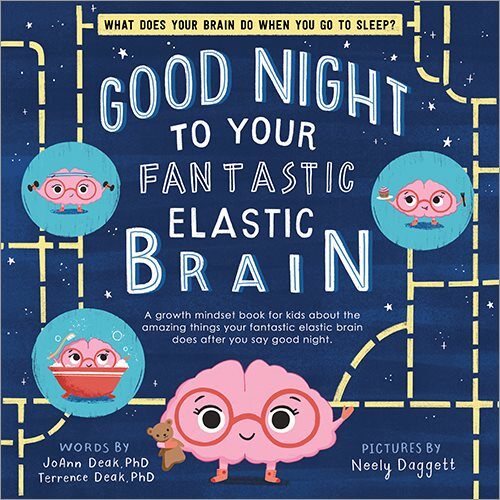
Gonna level with you. I don’t trust PhDs when I see them behind the names of children’s picture book authors. 9 times out of 10 that book is relying on the author’s expertise, in a field that is NOT children’s literature, to carry the weight of the text. And just because you know the ins and outs of preventative psychology or behavior neuroscience, that’s no guarantee that you know how to intrigue kids. This book? Intrigues kids. Intrigues adults too, come to think of it. It’s a lovely run down not of the brain as a whole, but just in terms of why we need sleep and what it means for your brain. The friendly pictures by Neely Daggett turn out to be the ideal complement to the text which, I was delighted to see, was consistently and appropriately written with young readers in mind. It doesn’t talk down to them but it also doesn’t go over their heads. My favorite part? When you’re given the “Brain’s Nighttime Checklist” of things it needs to get done when you’re sleeping (“take a bath” is FASCINATING!). Kids won’t go to bed on time? Hit ‘em with this book and logic them into sleep. It makes a case so strong, the parents may even listen too!
How Big is Your Paw? Forest Animals by Kristin J. Russo

Am I the only one who sees this title and immediately starts singing, “How Deep Is Your Love” every time? Yes? Just me? Figured as much. Now this little board book has a lot of the same appeal as that old Steve Jenkins title Actual Size. It shows a range of animals’ paws, and you can compare how big they are to your own hand. So it starts out little (it’s really interesting that the smallest prints don’t always come from the smallest animals) and then grows to the point where your hand is pressing up against the prints of a bear and moose. Now a lot of the text pays the price of being too old for babies and preschoolers . . . but not all of it. There is, I noticed, a small part in darker print with simpler words that you could read to younger readers. The rest of it could be for their older siblings, hanging around, wanting to press their own grimy digits against the prints. Interactive and a lot of fun, I’m willing to forgive it its occasional loquaciousness.
How to Say Hello to a Worm: A First Guide to Outside by Kari Percival

“Sprinkle, sprinkle, sprinkle. Pat, pat, pat. Now make some rain!” Earliest readers will love this deep dive (sometimes literally!) into gardening, growing, and learning. Ah! The holy grail! A very young reader on science and worms and nature and taking care of something that grows. I’m not going to say it’s groundbreaking work, but for the age range that it’s aimed towards, I think it does a very good and very successful job of going through some rudimentary garden ideas. I’m also pretty pleased with how inclusive it is, and with the art itself. The fronds on the tops of the carrots alone are gorgeous. Definitely worth more eyeballs.
Listen to the Language of the Trees: A Story of How Forests Communicate Underground by Tera Kelley, ill. Marie Hermansson
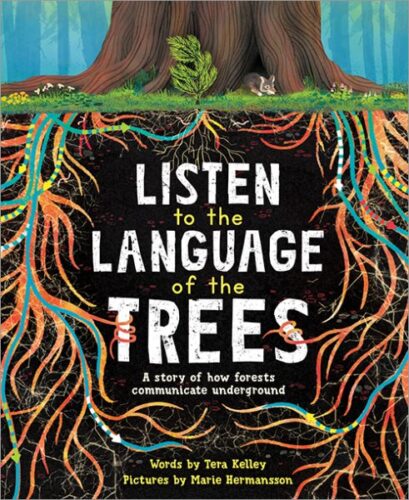
Think trees can’t communicate? Think again. Trees have a whole underground system of sending nutrients, messages, and even alarm systems to one another. Learn more about this amazing wood wide web. You’ll never look at a tree the same way again. Finally! I’ve been waiting and waiting for this book to come out. Ever since I first learned about the marvelous methods trees have of communicating and sending one another help, I’ve wanted a book like this one to exist. And we’ve seen some books that vaguely alluded to the wood wide web (not my phrase) but nothing that really went this deep into it. This book, honestly and truly, will make you look at trees differently when you read it. Not too long ago I was in Michigan and found myself staring at trees along the highway, trying to figure out which ones were the matriarchs that helped everyone else. This book is marvelous and necessary. Yay, trees!
Make Way For Animals: A World of Wildlife Crossings, by Meeg Pincus, ill. Bao Luu

Take a tour of wildlife crossings across the globe, from grassy badger bridges to underpasses for elephants. Discover how these inventive pathways have saved both animal and human lives and helped preserve ecosystems. A year or two ago I almost missed a book on animal crossings called Crossings by Katy S. Duffield (to say nothing of Cougar Crossing by Meeg Pincus). So it is with great pleasure that I see that I’ve found another wildlife crossing title, and, not only that, it’s great! Those videos of the crabs of Christmas Island have always given me a lot of stress, since I worry for them so much. As such, you can understand how thrilled I was to see their truly bizarre, entirely vertical, crossing mechanism. I love the structure of this book and how it sets up the animals in the first part and their individualized solutions in the second. I love the innovation it takes to help them (and how it’s in everyone’s best interests, not just the animals themselves). Great backmatter with photographs, info on what kids can do, and a Bibliography. This is a real treat.
Mega-Predators of the Past by Melissa Stewart, ill. Howard Gray

Forget the dinosaurs! Meet the REAL (and enormous) mega-predators of the past. All but one is extinct… but which one? Ahhh. This is like the book Actual Size meets … uh …. stuff that could eat you. It’s clear from the outset that Stewart knows how to do this nonfiction stuff, and do it well. This takes some standard elements in books in terms of scale and makes them fun. For example, every time they show a little person’s silhouette for scale, that silhouette is usually fleeing, falling, flailing, or trying to defend itself from the animal being discussed. The writing itself is fun and funny (it’s continually besmirching dinos and how they dominate discussions of ancient predators). And then you get to the explanation of how Stewart did her research and you are left with NO doubts that this book is, for this moment, as accurate as it could possibly be.
One Tiny Bubble: The Story of Our Last Universal Common Ancestor by Karen Krossing, ill. Dawn Lo

Since I’ve a knee jerk reaction to anthropomorphizing, I was a bit worried when I saw somewhere that this book was about a “squishy blob with no legs or arms” named LUCA. As if anticipating folks like myself, Karen Krossing is quick to state right from the start that LUCA simply stands for “Last Universal Common Ancestor”. And what is that exactly? Well, it’s not the first sign of life on this planet. I know that might be what you’re thinking, but nope. Not quite. Instead, Krossing’s text explains, very clearly and plainly in a way that a child (or I) could understand that “LUCA was not the first life-form to exist on Earth, but it was the last one before life began to branch into many different and unique beings”. My brain hurts when I try to think of all the different ways to tell this story that Krossing must have thought up and ultimately rejected. Ultimately, we get a sense of how LUCA might have been created (the line “one tiny bubble ballooned into a thin membrane” may have broken my own brain a little) and the implications of the right set of circumstances in other places across the universe. It’s so friendly and fun with the help of Dawn Lo’s illustrations. Plus, if you’re feeling up to it, pair it alongside this year’s The Universe in You: A Microscopic Journey by Jason Chin. What better way to make our kids feel huge?
Out of This World: Star-Studded Haiku by Sally M. Walker, ill. Matthew Trueman

“hugged by gravity / eight planets bask in sunlight / solar family.” Gentle haikus introduce young readers to the cosmos itself while accompanying art makes the concepts palpable and real. It can be hard to resist space haiku combined with eye-popping mixed media art. Walker’s done haiku collections before (Earth Verse: Haiku from the Ground Up) but I like this particular change of pace. It starts with what I would consider the most easily spotted constellation in the sky, Orion, jumps to the Galileo and Hubble telescopes, and after that we’re off into the stars. Trueman gets to do everything from the Big Bang to Jupiter’s red eye in this book, and I just found it a lot of fun. Copious backmatter tells more (I had no idea that Ultima Thule looked like a space snowman) but you could easily use this book to introduce a lot of these concepts to young readers who are new to our solar system and beyond.
The Poem Forest: Poet W.S. Merwin and the Palm Tree Forest He Grew From Scratch by Carrie Fountain, ill. Chris Turnham

Faced with land poisoned by pollution, poet W.S. Merwin slowly started planting trees. Learn the tale behind the world’s most comprehensive palm forest in the world. While I always view books with a potential white savior plotline with a bit of trepidation, I’m happy to report that this one won me over. It’s such a cool tale of taking polluted land and turning it into a palm forest. Now I did wonder about non-native plants and if that ever came up. I also wondered about who owned the land before Merwin, and whom it was taken from. None of that is discussed, so let’s bear that in mind as we consider this book. Still and all, it’s a deeply satisfying story the way it’s rendered here. Certainly worth some consideration.
Polar Bear by Candace Fleming, ill. Eric Rohmann

A mama bear and her two cubs wake from their winter hibernation and search for food. A gripping, beautifully illustrated account of the toll global warming takes on species. Shoot. I was all prepared not to take the latest Fleming/Rohmann collaboration seriously since I’d already lavished SO much love and affection on their bee book from a year or two ago. Plus, polar bears? So done. So very done. I’ve read more nonfiction picture books for them than I can count. And then there Candy goes being an actual author and making me really really REALLY care about the fate of these baby bears. On top of that, I thought I knew everything there was to know about them, only to find myself incredibly wrong. It’s a bit of a thrill too to see Rohmann doing polar bears again too (remember, he did the book jackets for the American editions of The Golden Compass back in the day). So I’m an official fan of this book. Didn’t wanna love it. Had no choice in the matter.
Ribbit! The Truth About Frogs by Annette Whipple
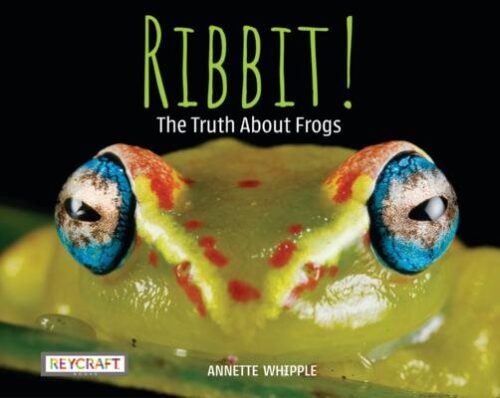
Eye-popping (eye-hopping?) photography of some of the most interesting frogs in the world is paired alongside a wonderful array of fun frog facts. Find out what frog is the most poisonous, what frog is the fastest, and whether or not frogs and toads are related. Fabulous froggy fun! Foof! This one’s a beauty. Because this is a Reycraft book I missed the previous books by Whipple in this series like Scurry about spiders. A true pity since this book is a hoot! Fantastic photography (the cover’s a good indication of that) and a really nice breakdown of information makes this the go to book on rudimentary frog info. I also respect any nonfiction book for kids that teaches me something new. Did you know that toads are technically frogs? I had no idea! Beautifully laid out and put together. Frog lovers are about to get a real treat.
A River’s Gifts: The Mighty Elwha River Reborn by Patricia Newman, ill. Natasha Donovan
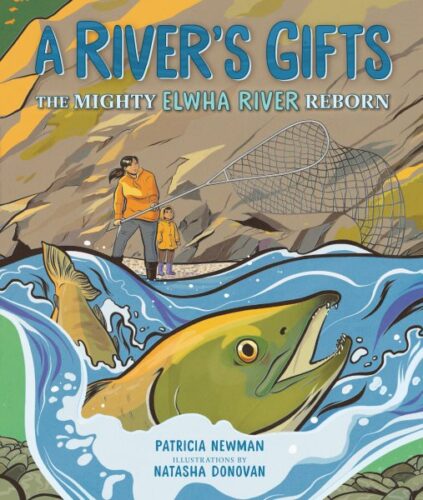
When the Elwha River was dammed up it not only decimated the salmon population but flooded the lands of the Lower Elwha Klallam Tribe. So what happens when you remove the dams? A powerful story of activism and nature’s recovery. Let the record show that for the first two or three pages of this book I was not initially on board. Something about it struck me as dull, I guess. So glad I stuck with it, though! This book is a marvelous companion to this year’s THE WOLVES OF YELLOWSTONE since, in both cases, people muck with nature, restore nature, and then are surprised when restoring nature has unintended good consequences. Donovan’s art is the perfect companion to Newman’s text. It actually becomes rather tense at the end when the dams have been removed and everyone’s wondering if the salmon will return. We don’t have enough truly happy historical environmental stories out there. This is one of the few, so cherish it.
Serengeti: Plains of Grass by Leslie Bulion, ill. Becca Stadtlander
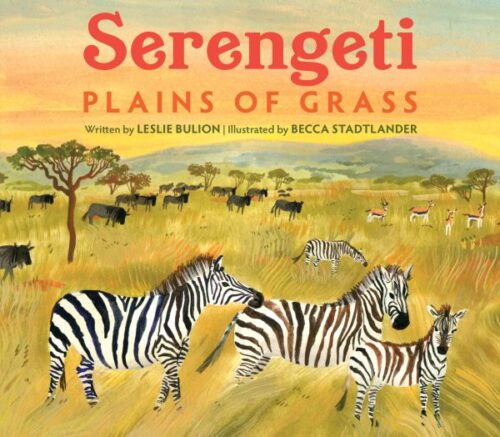
“Parched soil bed of volcano ash / roots asleep in a tangled mesh.” Lyrical poetry brings to vibrant life the interconnectedness of bugs, plants, and animals in a singular ecosystem. Hold the phone! Hold your horses! Stop right there and put aside your skeptical raised eyebrows. Yes, this is another Serengeti book. Yes, we are all a little tired of the Serengeti at this point. And yes, this cover, like the stripes on a zebra, camouflages it so that it is indistinguishable from all the other Serengeti books out there. That said, this may well be the best book I’ve seen to really dig down and explain the interconnected nature of life in this particular habitat. Ignore the first page that’s just full of text. I don’t know why that’s there. Should have been in the backmatter. Once you get beyond that you’ll encounter the poems, which are good, and highlight this really cool link between different species in a single space. Kids hear a lot of talk about “the circle of life” and all that. This book makes it a lot more real than I’ve found elsewhere. Evocative and informative.
Solitary Animals: Introverts of the Wild by Joshua David Stein, ill. Dominique Ramsey

Vibrant pulsating images show how solitary animals and social animals differ. Simple words show how it’s okay to be by yourself, just like eagles, panthers, sloths, and more. Introverts of the world rejoice! We have found your animalian equivalents. This luscious but exceedingly simple book has one job and does it well. All it wants is to show how some animals exist in groups while others are happy alone. The backmatter is slightly wordier, but it keeps its points short and sweet. For example, humans are social animals that sometimes want to be solitary. And that’s okay.
The Tide Pool Waits by Candace Fleming, ill. Amy Hevron
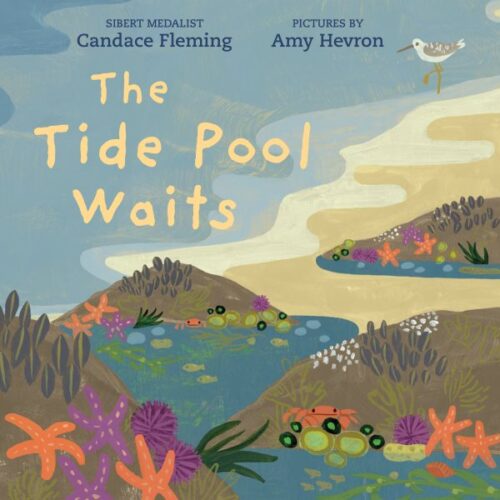
“Swish, gurgle, trickle, drip-drip-drop”. The waves crash in, a tide pool forms, and everything inside it waits. What are they waiting for? You’ll see. The natural ebb and flow of a tide pool is given a poetic feel in this gentle book. I liked the text very much and thought it provided a nice guide to a daily occurrence. Loved that backmatter too. There’s “An Illustrated Guide to This Tide Pool”, a “Let’s Explore” section, and a cool gradation of the spray zone down to the low tide zone.
Time to Shine: Celebrating the World’s Iridescent Animals by Karen Jameson, ill. Dave Murray

Do iridescent animals that gleam with flashing rainbow colors have that shine just to be pretty? Not on your life. Learn the science, secrets, and splendor behind some of the world’s most gorgeous creatures. It’s a bit of a challenge to dare to go so far as to write a book about iridescence if you’re a small book publisher like Groundwood. I imagine the biggies would have loads of cash to throw at their books, filling them with Rainbow Fish-esque iridescent interiors. This book, instead, has to rely entirely on artist Dave Murray’s ability to conjure a representation of iridescence without presenting it himself. You will find a bit of foil on the cover around the title for reference, but it’s awfully spare. All that aside, the information in this book is a lot of fun. I just figured iridescence was created to attract mates, and that does appear to be the most common reason, but there are other interesting applications as well, like frightening off a predator, confusing their eyes. There’s a nice list of Sources at the back and I got so intrigued by the notion of the Caihong juji (a duck-sized dino with, apparently, iridescent feathers) that I want a whole book about THAT now!
To Change a Planet by Christina Soontornvat, ill. Rahele Jomepour Bell
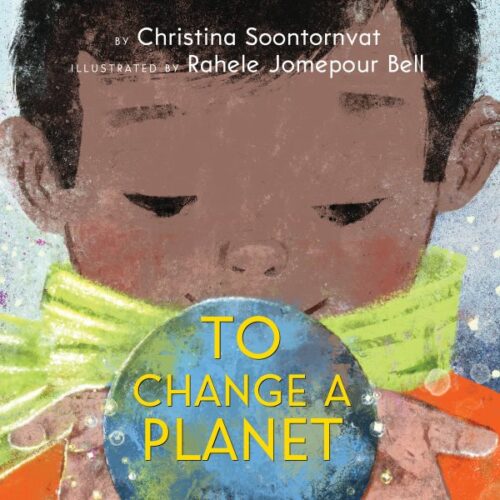
Can one person affect a whole planet? A very young picture book for budding environmentalists shows just how important each and every person is to Earth’s future. Proving yet again that she can literally write any kind of children’s book you can name (she has produced a graphic novel, middle grade fantasy, a picture book bio at least in 2022), Soontornvat is adding “quiet nonfiction environmental paean” to that list. This book seems tailor made for young child Earth Day storytimes. The words are incredibly simple but combined with Bell’s art they convey sentiments that go far beyond the book’s seeming simplicity. It’s a book meant to show how important a single person is to the planet and how important that planet is. Beautifully written with some killer art. The best version of this kind of book.
The Universe in You: A Microscopic Journey by Jason Chin

What is the tiniest, smallest thing in the known universe? From a delicate hummingbird to elementary particles and everything in-between, take a trip into your cells and our selves. So this is an interesting case. Considering that Chin’s last book (Your Place in the Universe) was also SO successful, I could acknowledge this book as equally awesome since it’s so much harder to show something getting smaller and smaller as opposed to bigger and bigger. But that said, its really remarkable quality is that Chin is most successful at trying to make such complicated ideas understandable for kids. The elementary particles were my favorite part (and I appreciated his mentioning at the end that he was just winging it on what they looked like). Well worth discovering.
What’s Up, Pup? How Our Furry Friends Communicate and What They Are Saying by Kersten Hamilton, ill. Lili Chin

As ever, it can be hard to find books for younger readers sometimes. In spite of its longish subtitle, this clever little title does a marvelous job of breaking down different types of doggie body language in your day-to-day interactions. It also rhymes, which was a nice plus, and wholly unexpected. It makes me think that this book could actually be used in STEM-related storytimes as well. Some of these movements you’ll already know, like showing a belly or peeing on things. But others were new to me. The tongue flick to the nose potentially meaning that they’re nervous. Sniffing the ground to say that they need space. It’s all explained in the excellent backmatter at the end, alongside an Author’s Note and a Select Bibliography. Fun!
For Older Readers
Buzzkill: A Wild Wander Through the Weird and Threatened World of Bugs by Brenna Maloney, ill. Dave Mottram
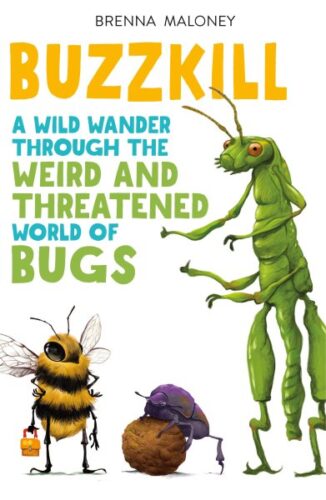
I came this close to missing this book. It was only through the intervention of a friend (and well-respected author) that it even came to my attention. Without revealing this friend’s identity, this person is a much better writer than I will ever be and so I put to you a small portion of the recommendation that convinced me to pick this up:
“She’s [Maloney] not only a very funny writer, doing a kind of stand-up about insects (she’s a big researcher) but she’s an incredibly elegant one with metaphors. For example, she talks about the noise cicadas make and she describes the process as being very like the way you make noise expanding and contracting a bendy straw. What kid hasn’t made that bendy-straw noise? When she talks about molting, she explains that the new exoskeleton has to be bigger than the old one, so it’s like having a heavy winter coat underneath a thin, sweat-soaked tee shirt—you have to peel off that tee-shirt very carefully, and lots of times a leg gets torn off in the process. Everything is explained with the utmost clarity, as if she were standing by your elbow.”
The book itself is a whopper, clocking in at a whopping 378 pages. Your kids will read every word. So it is gross? And how! Whether Brenna Maloney is eating mealworms (not crickets, though), talking about eyelash mites, discussing the loudest animal in the world (the water boatman bug that makes the sound by hitting its penis against its abdomen), or what have you, disgusting details abound and are so funny and so smart. I freakin’ love this book. Bugs, man. Who knew?
Cat Eyes and Dog Whistles: The Seven Senses of Humans and Other Animals by Cathy Evans, ill. Becky Thorns

You know your five senses, right? But were you aware that you really have SEVEN? And did you know that other animals might have even more? A fun trip into how we navigate the world around us. So this book looks an awful lot like other nonfiction children’s book imports from overseas, and it falls into some of the usual European traps (no Bibliography or listing of sources in the back). I was, however, pleasantly surprised to find that this title rises above the rest. First off, it has a Glossary and Index, which is very nice. But far better are the contents, which really do cover more than seven senses. I think I understand now why we only usually teach kids about five of them. The remaining two (Proprioception and the Vestibular System) are fascinating but don’t fall trippingly off the tongue. Still, I loved the sheer plethora of facts in this book.
Do Bears Poop in the Woods? by Huw Lewis Jones, ill. Sam Caldwell

Hey, Boo Boo!
Folks, I’ve seen my fair share of bear books in my time. Nonfiction authors for kids love the darn things. Who can blame them? Now you might take a gander at this title and come to the not improbable conclusion that this is a book about poop. It is not. And as far as I’m concerned, we’ve seen enough “All About Scat” type titles to last us a good decade from here on in. This here’s a bear book and that is that. Now a colleague of mine is awfully fond of those Max Eaton III animal books, and she pointed out that she still liked his The Truth About Bears more than this title. I don’t wholly disagree, but I think this book is bringing up bear ideas and facts that I’ve never really seen on the page for kids before. For example, there’s this marvelous section that outlines ALL these bears that have gone extinct. Some are prehistoric. Some were relatively recent (ever heard of the California grizzly bear with yellow fur that was called the Golden Bear?). But the whole book is just a great look at the sheer variation within the species and where it might be going in the future. In short, a bear book of the year, for certain.
Honeybee Rescue: A Backyard Drama by Loree Griffin Burns, photos by Ellen Harasimowicz
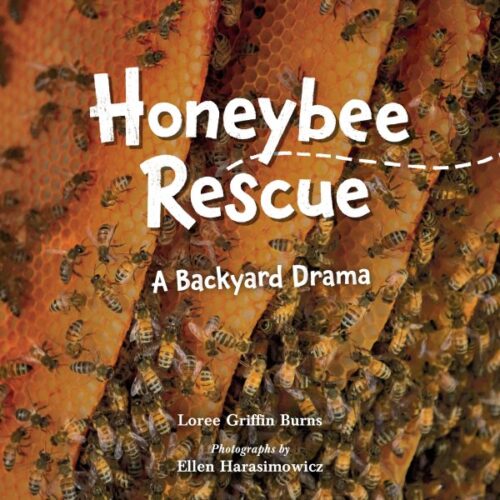
Uh-oh. Bees have moved into a rickety old barn. Who will move them to a safe spot before the winter? It’s Mr. Nelson, the bee rescuer! An informative and fun look at finding honeybees a brand new home. How much do I love this slightly older nonfiction book? Let me count the ways. I’ve heard of relocating hives of bees before but I always thought it just happened when homeowners found them to be nuisances or something. This is such a meticulous and fascinating encapsulation of the process. Honestly, you could probably sell it on the basis of the gentle bee vacuum alone. And I have the same reaction to seeing Jon Nelson handle live bees with his bare hands as I do to watching someone free solo. Which is to say: abject terror. Burns outdoes herself. This should be in every library.
How to Build a Human in Seven Evolutionary Steps by Pamela S. Turner, ill. John Gurche

How do you make a human? How many “cousins” on our family tree were there? The mysteries of evolution abound in this funny, fascinating, and completely up-to-date deep dive into humanity’s origins. Well, this is very much my jam, and it did not disappoint. I read a Goodreads review of this where a librarian was lamenting the fact that they’d had to weed their copy of Lucy Long Ago because it came out in 2009 and the information was now out-of-date. This book, she crowed, was a perfect updated edition of very much the same information. Better, I’d say. I loved Lucy but this gives such a loving look at the full swath of ancient ancestors that were out there. Plus, Turner has this amazing sense of humor. Hope you like snarky footnotes because this book delivers! The art by John Gurche is particularly nice. I’m still a bit floored by the fact that an Erectus guy like Nariokotome Boy was full grown at the age of 8. So many facts! And finally, that Author’s Note on the end on race is so needed and so necessary. Incredible.
I Begin With Spring: The Life and Seasons of Henry David Thoreau by Julie Dunlap, ill. Megan Elizabeth Baratta
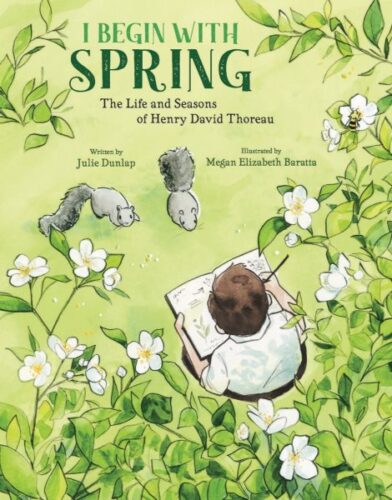
How can one man living in a cabin in the woods make any kind of a difference? The life and writings of Thoreau are explored in a playful, engaging notebook of a book, showing his influence both then and on people today. As it turns out, this is a dive into the life of Henry David Thoreau, but told in such a way as if you were you reading through one of his journals. There’s a running timeline on the bottom of the pages, as the seasons pass, noting when the first bank swallow is seen or when he collects white pine cones. It makes a pretty strong case not simply for why David’s life was important (civil disobedience and his vehement dislike of slavery are cited multiple times) but also his scientific work. I found the backmatter on how current climate change scientists are able to use his meticulous notes to be fascinating. I do wish there had been some mention of the fact that yeah, he lived in the woods but his mom did all his laundry, but all told it’s a strong piece with some killer backmatter. A must read!
A Leopard Diary: My Journey Into the Hidden World of a Mother and Her Cubs by Suzi Eszterhas

Did you ever wonder about the sheer amount of work that sometimes goes into the creation of a book? As I read through Suzi Eszterhas’s work traveling to and from Botswana, tracking leopards (noted as being “famously shy”) so as to photograph them at a very young age (also hard to do), I decided that there must have been multiple reasons for this beyond the book. As it stands, however, A Leopard Diary is an incredibly impressive title! It’s also a great process title. You really get to see how much work it takes to keep tabs on leopards and care for them from afar. Written in a diary format, the book is just packed full of photos and facts. Almost as important? The design of the whole thing is fun and accessible. Though the text is for older readers, it’s just 40 pages long, so it doesn’t scare you off with its size. Big cat loving kids will just eat this up too cause this thing is packed full of baby leopards of various sizes. Baby leopards, people! Are you made of stone!?
Operation Pangolin: Saving the World’s Only Scaled Mammal by Suzi Eszterhas

Shy creatures make for great nonfiction. Particularly when their books are the perfect length and the perfect ratio of text to image. If I’m a kid who has to do a report on pangolins, or simply heard of them and got interested (they were certainly in the news a lot at the beginning of the pandemic) then I would want to see a LOT of photographs of them in a book. Some nonfiction for older kids limits how many images they can include. Credit Millbrook Press then for committing to the bit and just filling page after page in this title with pangolins galore. Clocking in at a mere 40 pages (so it never feels overwhelming, but also never feels like a picture book) Eszterhas lays out the information perfectly. You meet Thai Van Nguyen, one of the very few pangolin researchers in the world, right at the start. Then you learn about the animals, you learn about how Thai and others are educating people on pangolins, and there’s a great section at the end on how kids can help (always a plus). By the end you won’t just be vowing never to eat the critters. You’ll be vowing to single-handedly save them yourself! A marvelous example of older nonfiction that won’t scare off the informational text newbies.
Packing for Mars for Kids by Mary Roach

Did you know that a human body never feels like it has to pee in zero gravity? Did you know that showers don’t work in space? Or that after a couple weeks your nose stops noticing bad body odors? Join Mary Roach for the grossest trip to the stars you will ever EVER encounter. Folks, I don’t want to overhype this, but I think this may well be the grossest nonfiction book for kids I have ever read in my life. You know all those books on poop and snot and what have you? None of them can hold a candle to this. Now generally I dislike Young Reader’s Editions of any adult titles, but Roach’s original book (Packing for Mars: The Curious Science of Life in the Void) came out in 2010. I’d say 12 years is about the right amount of time to get a younger version right. I do desperately wish they’d renamed it, though. Though the book is about life in space, there’s almost no mention of Mars itself until then end, so Mars-hungry kids are going to be pretty disappointed. Also, this book takes about three chapters to really get going. The first two are fine, but I did think about stopping more than once. Then we started talking toilets and everything got really crazy, really fast. I learned so much that I can never unlearn. Let’s just say the section on fecal bags may have scarred me for life. A winner!
Save the People: Halting Human Extinction by Stacy McAnulty, ill. Nicole Miles
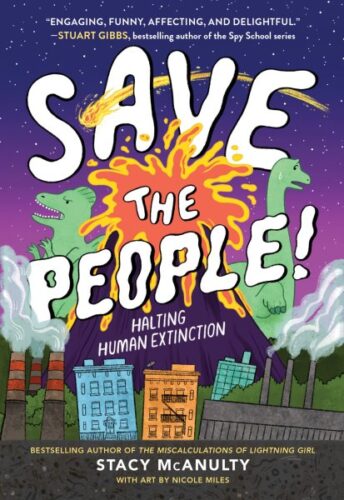
Mass extinction! For kids! And it’s funny! What are all the different ways extinctions have happened in the past and what are the possible ways humans could disappear in the future? A remarkably hilarious look at mass destruction. This is an ideal book for the kind of kid obsessed with all the different ways the human race could go belly up. Failing that, it’s a book for the kid who comes to your desk asking for Titanic/Donner Dinner Party/etc. titles. The catastrophe kid. And believe me, there are a lot of kids out there like that. While I wouldn’t necessarily hand it to an anxious kid, McAnulty’s latest magnum opus really handles its dire material in as enjoyable a way as possible. I had no idea that volcanoes were much more dire than asteroids when it comes to the possible destruction of humanity. Let’s hope that Stacy McAnulty does a lot more nonfiction in the future. Sole downside? I cannot read this title without getting the Godspell song “God Save the People” caught in my head. Every. Single. Time.
The Wolves of Yellowstone A Rewilding Story by Catherine Barr, ill. by Jenni Desmond
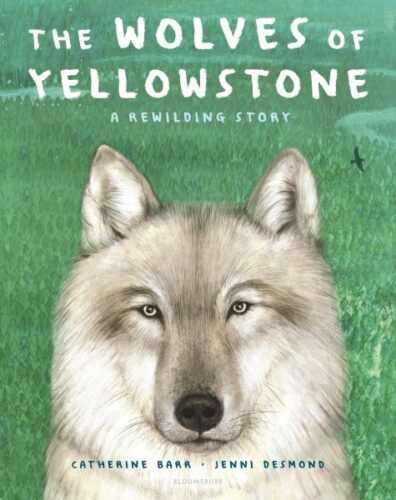
For 69 years wolves were gone from Yellowstone National Park and the landscape suffered. When they were reintroduced in 1995, not everyone was happy about it. And no one could have predicted what would happen next… Very good! We’ve seen a couple books that do what this one is doing, but I like the format here. Sure, there’s a ton of text on these pages, but for kids interested in the subject (and how could you not be?) it reads really well. And I always like to know what happens later in a story, so showing the original wolves and how and when they died is highly informative. A straightforward take on interspecies reliance, and how a landscape sometimes requires an apex predator or two.
The World’s Most Ridiculous Animals by Philip Bunting
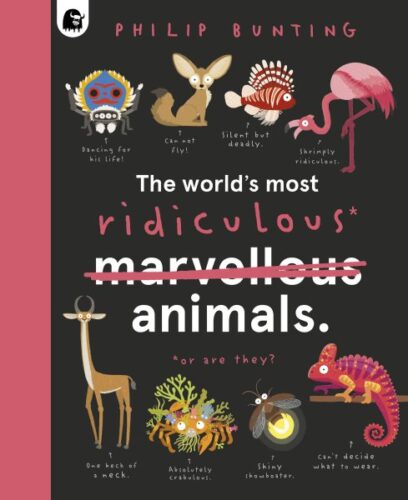
It’s as if Philip Bunting said to himself, “To please Betsy this year, I shall include an entry into my World’s Most series that contains not one but TWO Simpsons references on the same page!” I’m not even kidding. Check out the entry on tardigrades if you don’t believe. Now I included a Philip Bunting book on a previous year’s list as well (in that case it was The World’s Most Pointless Animals) and I was gratified to see that that book must have sold pretty well since Happy Yak tapped the man to write another in the same vein. Here the only impetus is for these creatures to be interesting. As such you’ll get gross critters like the zombie snail and strangely pretty ones like the ribbon eel. Guaranteed you’ll learn something from this, plus the joke density is fairly high. Even if you don’t know The Simpsons (in which case, how are we even friends?) you’ll find a lot to laugh at here.
Want to see other lists? Stay tuned for the rest this month!
December 1 – Great Board Books
December 2 – Picture Book Readalouds
December 3 – Simple Picture Book Texts
December 4 – Transcendent Holiday Picture Books
December 5 – Rhyming Picture Books
December 6 – Funny Picture Books
December 7 – CaldeNotts
December 8 – Picture Book Reprints
December 9 – Math Books for Kids
December 10 – Gross Books
December 11 – Books with a Message
December 12 – Fabulous Photography
December 13 – Translated Picture Books
December 14 – Fairy Tales / Folktales / Religious Tales
December 15 – Wordless Picture Books
December 16 – Poetry Books
December 17 – Unconventional Children’s Books
December 18 – Easy Books & Early Chapter Books
December 19 – Comics & Graphic Novels
December 20 – Older Funny Books
December 21 – Science Fiction Books
December 22 – Fantasy Books
December 23 – Informational Fiction
December 24 – American History
December 25 – Science & Nature Books
December 26 – Unique Biographies
December 27 – Nonfiction Picture Books
December 28 – Nonfiction Books for Older Readers
December 29 – Best Audiobooks for Kids
December 30 – Middle Grade Novels
December 31 – Picture Books
Filed under: 31 Days 31 Lists, Best Books, Best Books of 2022
About Betsy Bird
Betsy Bird is currently the Collection Development Manager of the Evanston Public Library system and a former Materials Specialist for New York Public Library. She has served on Newbery, written for Horn Book, and has done other lovely little things that she'd love to tell you about but that she's sure you'd find more interesting to hear of in person. Her opinions are her own and do not reflect those of EPL, SLJ, or any of the other acronyms you might be able to name. Follow her on Twitter: @fuseeight.
ADVERTISEMENT
ADVERTISEMENT
SLJ Blog Network
One Star Review, Guess Who? (#202)
Exclusive: Giant Magical Otters Invade New Hex Vet Graphic Novel | News
Parsing Religion in Public Schools
Take Five: LGBTQIA+ Middle Grade Novels
ADVERTISEMENT








Very cool! Always look forward to see the lists. Thank you.